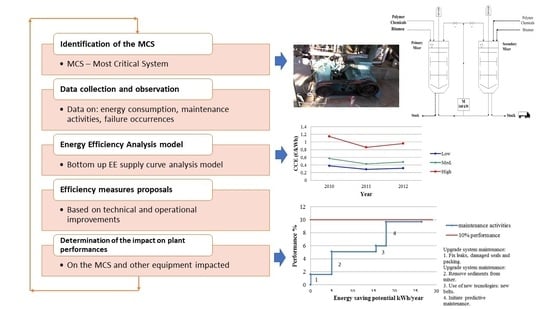Using Field Data for Energy Efficiency Based on Maintenance and Operational Optimisation. A Step towards PHM in Process Plants
Abstract
1. Introduction. A Framework for the Energy Efficiency Improvement
- Identification of the most critical system. Depends on the energy consumed by the single equipment or system.
- Data collection and observation. Lifetime observation and data collection about energy consumption, corrective and preventive maintenance activities, and failures occurrence. It includes the maintenance costs estimation, the economic evaluation of maintenance policies, and the estimation of the operating costs of the system.
- Energy Efficiency model. Analysis of the energy efficiency benefits, using an energy efficiency model, as further discussed in Section 2.
- Efficiency measures proposal. Definition of scenarios and efficiency measures.
- Determination of the impact of the proposed measures on the performance of the plant, when considering both the equipment under analysis and other pieces of equipment or systems that could be affected by the measures implemented.
2. Energy Efficiency Models
3. Energy Efficiency Measures Identification and Optimization
- (1)
- development of a baseline information from literature and technical data;
- (2)
- energy audit and data collection;
- (3)
- expert knowledge input; and,
- (4)
- definition of base efficiency scenarios and proposal of operational and technical measures of improvement.
- enhancement and upgrading of existing maintenance procedures;
- adoption of new technologies and more efficient devices; and,
- design of a predictive maintenance program.
4. Bitumen Processing Case Study
4.1. Data Collection and Observation
4.2. Economic Evaluation of Maintenance and Operating Costs
4.2.1. Maintenance Costs
4.2.2. Operating Costs
4.3. Efficiency Analysis
- (1)
- The efficiency base case scenarios for motor system, as discussed in Section 3.
- (2)
- The measures proposed to increase the energy efficiency of the motor system, together with the possible % improvement, according to the different scenarios.
- (3)
- The annual electricity used by the motor system.
4.4. Efficiency Analysis
4.5. Conservation Supply Curve
5. Conclusions
Acknowledgments
Author Contributions
Conflicts of Interest
References
- Worrell, E.; Laitner, J.; Ruth, M.; Finman, H. Productivity benefits of industrial energy efficiency measures. Energy 2003, 28, 1081–1098. [Google Scholar] [CrossRef]
- Cantore, N. Factors affecting the adoption of energy efficiency in the manufacturing sector of developing countries. Energy Effic. 2017, 10, 743–752. [Google Scholar] [CrossRef]
- Zhiqiang, G.; Huachao, G.; Yanqing, W.; Yongming, H.; Qunxiong, Z. Energy saving analysis and management modeling based on index decomposition analysis integrated energy saving potential method: Application to complex chemical processes. Energy Convers. Manag. 2017, 145, 41–52. [Google Scholar] [CrossRef]
- Rao, X.; Jun, W.; Bin, L. Energy efficiency and energy saving potential in China: An analysis based on slacks-based measure model. Comput. Ind. Eng. 2012, 63, 578–584. [Google Scholar] [CrossRef]
- Ang, B.W.; Wang, H. Index decomposition analysis with multidimensional and multilevel energy data. Energy Econ. 2015, 51, 67–76. [Google Scholar] [CrossRef]
- Lin, B.; Moubarak, M. Estimation of energy saving potential in China’s paper industry. Energy 2014, 65, 182–189. [Google Scholar] [CrossRef]
- Meier, A.K. Supply Curves of Conserved Energy. Ph.D. Thesis, University of California, Berkley, CA, USA, 1982. [Google Scholar]
- Koomey, J.; Rosenfeld, A.H.; Gadgil, A. Conservation Screening Curves to Compare Efficiency Investments to Power Plants: Applications to Commercial Sector Conservation Programs. In Proceedings of the 1990 ACEE Summer Study on Energy Efficiency in Buildings, Asilomar, CA, USA, 28 August–3 September 1990; American Council for an Energy Efficient Economy: Asilomar, CA, USA, 1990; pp. 5115–5124. [Google Scholar]
- Lutsey, N.P. Prioritizing Climate Change Mitigation Alternatives: Comparing Transportation Technologies to Options in Other Sectors. Ph.D. Thesis, Institute of Transportation Studies University of California, Davis, CA, USA, 2008. [Google Scholar]
- Hasanbeigi, A.; Menke, C.; Therdyothin, A. The use of conservation supply curves in energy policy and economic analysis: The case study of Thai cement industry. Energy Policy 2010, 38, 392–405. [Google Scholar] [CrossRef]
- Fleiter, T.; Hirzel, S.; Worrell, E. The characteristics of energy-efficiency measures—A neglected dimension. Energy Policy 2012, 51, 502–513. [Google Scholar] [CrossRef]
- Brunke, J.C.; Blesl, M. A plant-specific bottom-up approach for assessing the cost-effective energy conservation potential and its ability to compensate rising energy-related costs in the German iron and steel industry. Energy Policy 2014, 67, 431–446. [Google Scholar] [CrossRef]
- Muchiri, P.; Pintelon, L.; Gelders, L.; Martin, H. Development of maintenance function performance measurement framework and indicators. Int. J. Prod. Econ. 2011, 131, 295–302. [Google Scholar] [CrossRef]
- Abdelaziz, E.A.; Saidur, R.; Mekhilef, S. A review on energy saving strategies in industrial sector. Renew. Sustain. Energy Rev. 2011, 15, 150–168. [Google Scholar] [CrossRef]
- Bunse, K.; Vodicka, M.; Schönsleben, P.; Brülhart, M.; Ernst, F.O. Integrating energy efficiency performance in production management—Gap analysis between industrial needs and scientific literature. J. Clean. Prod. 2011, 19, 667–679. [Google Scholar] [CrossRef]
- Therkelsen, P.; McKane, A. Implementation and rejection of industrial steam system energy efficiency measures. Energy Policy 2013, 57, 318–328. [Google Scholar] [CrossRef]
- Zio, E.; Compare, M. Evaluating maintenance policies by quantitative modeling and analysis. Reliab. Eng. Syst. Safety 2013, 109, 53–65. [Google Scholar] [CrossRef]
- Faccio, M.; Persona, A.; Sgarbossa, F.; Zanin, G. Industrial maintenance policy development: A quantitative framework. Int. J. Prod. Econ. 2014, 147, 85–93. [Google Scholar] [CrossRef]
- Rosmaini, A.; Shahrul, K. An overview of time-based and condition-based maintenance in industrial application. Comput. Ind. Eng. 2012, 63, 135–149. [Google Scholar] [CrossRef]
- Selcuk, S. Predictive maintenance, its implementation and latest trend. J. Eng. Manuf. 2016, 231, 1670–1679. [Google Scholar] [CrossRef]
- Darabnia, B. An Interactive Decision Support System for Energy Management in Process Industry. Ph.D. Thesis, Politecnico di Torino, Torino, Italy, 2013. [Google Scholar]
- De Almeida, A.; Fonseca, P.; Bertoldi, P. Energy-efficient motor systems in the industrial and in the services sectors in the European Union: Characterisation, potentials, barriers and policies. Energy 2003, 28, 673–690. [Google Scholar] [CrossRef]
- Herrero Sola, A.V.; de Miranda Mota, C.M.; Kovaleski, J.L. A model for improving energy efficiency in industrial motor system using multicriteria analysis. Energy Policy 2011, 39, 3645–3654. [Google Scholar] [CrossRef]
- Singh, R.; Gohil, A.M.; Shah, D.B.; Desai, S. Total Productive Maintenance (TPM) Implementation in a Machine Shop: A Case Study. Procedia Eng. 2013, 51, 592–599. [Google Scholar] [CrossRef]
- McKane, A.; Hasanbeigi, A. Motor systems energy efficiency supply curves: A methodology for assessing the energy efficiency potential of industrial motor systems. Energy Policy 2011, 39, 6595–6607. [Google Scholar] [CrossRef]
- Tijdink, M.J.S.; Patel, A.; Zuberi, M.K. Techno-economic analysis of energy efficiency improvement in electric motor driven systems in Swiss industry. Appl. Energy 2017, 205, 85–104. [Google Scholar] [CrossRef]
- Darabnia, B.; Demichela, M. Data Field for Decision Making in Maintenance Optimization: An Opportunity for Energy Saving. Chem. Eng. Trans. 2013, 33, 367–372. [Google Scholar]
- Demichela, M.; Darabnia, B. Maintenance an opportunity for energy saving. Chem. Eng. Trans. 2013, 32, 259–264. [Google Scholar]
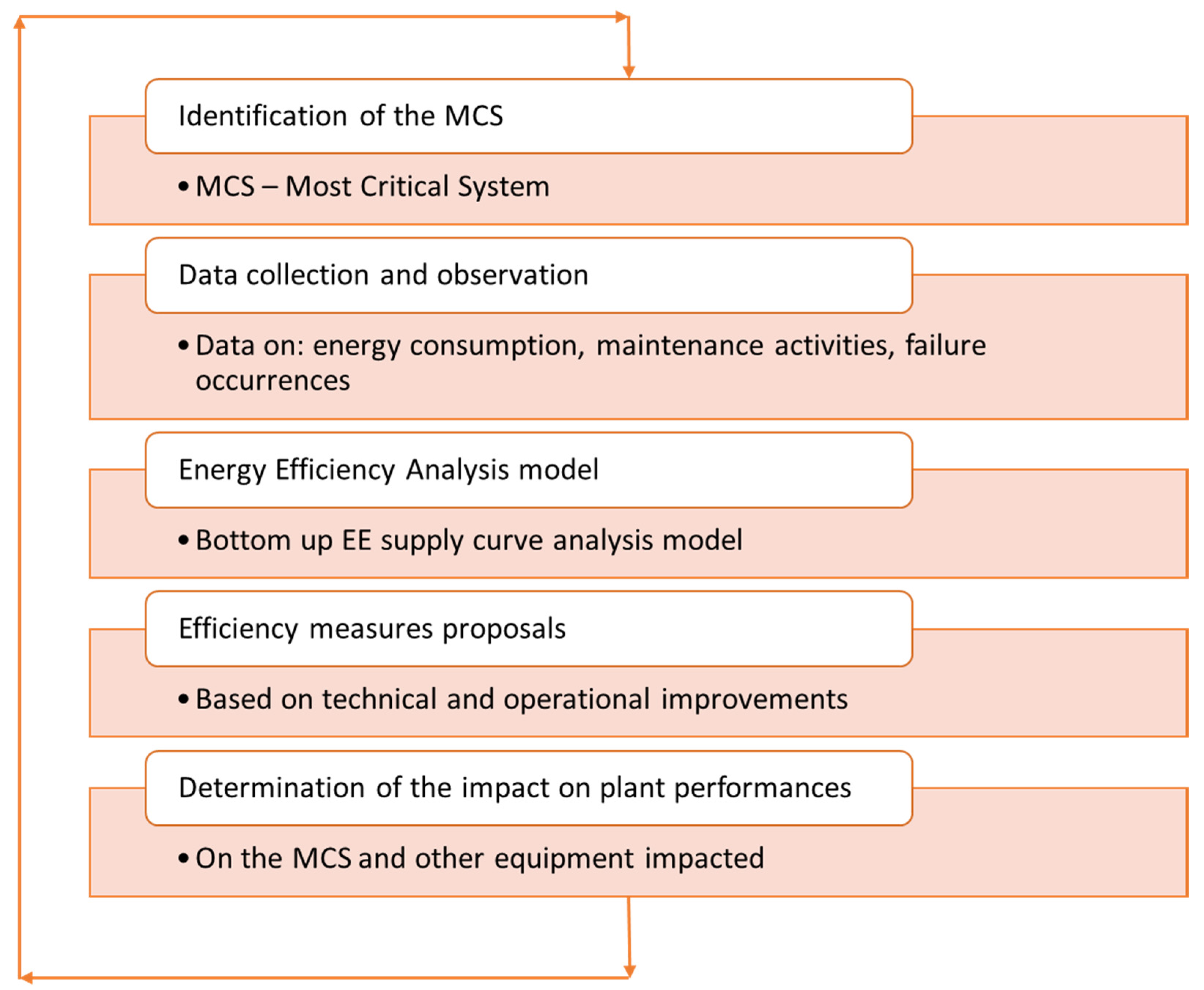
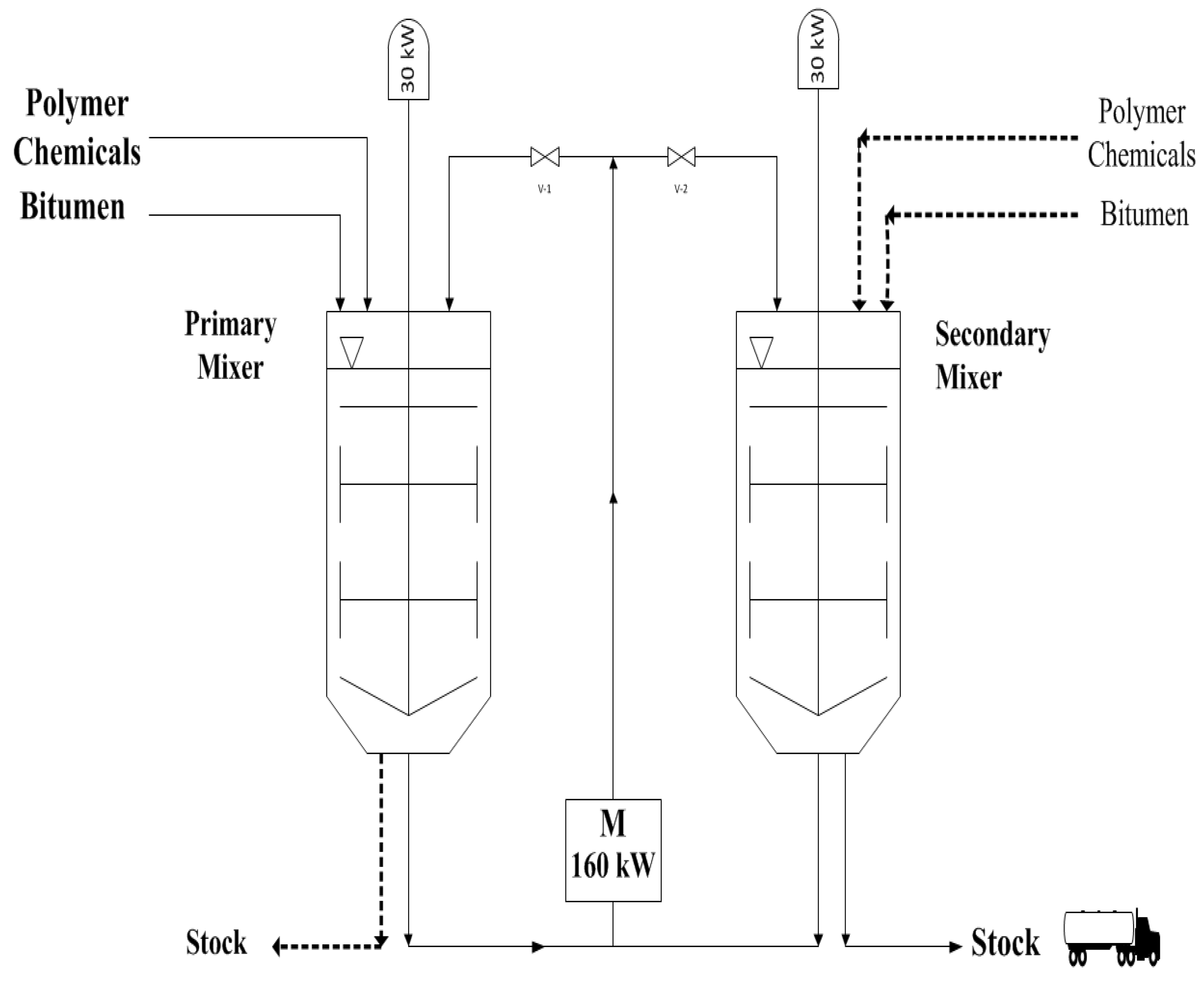
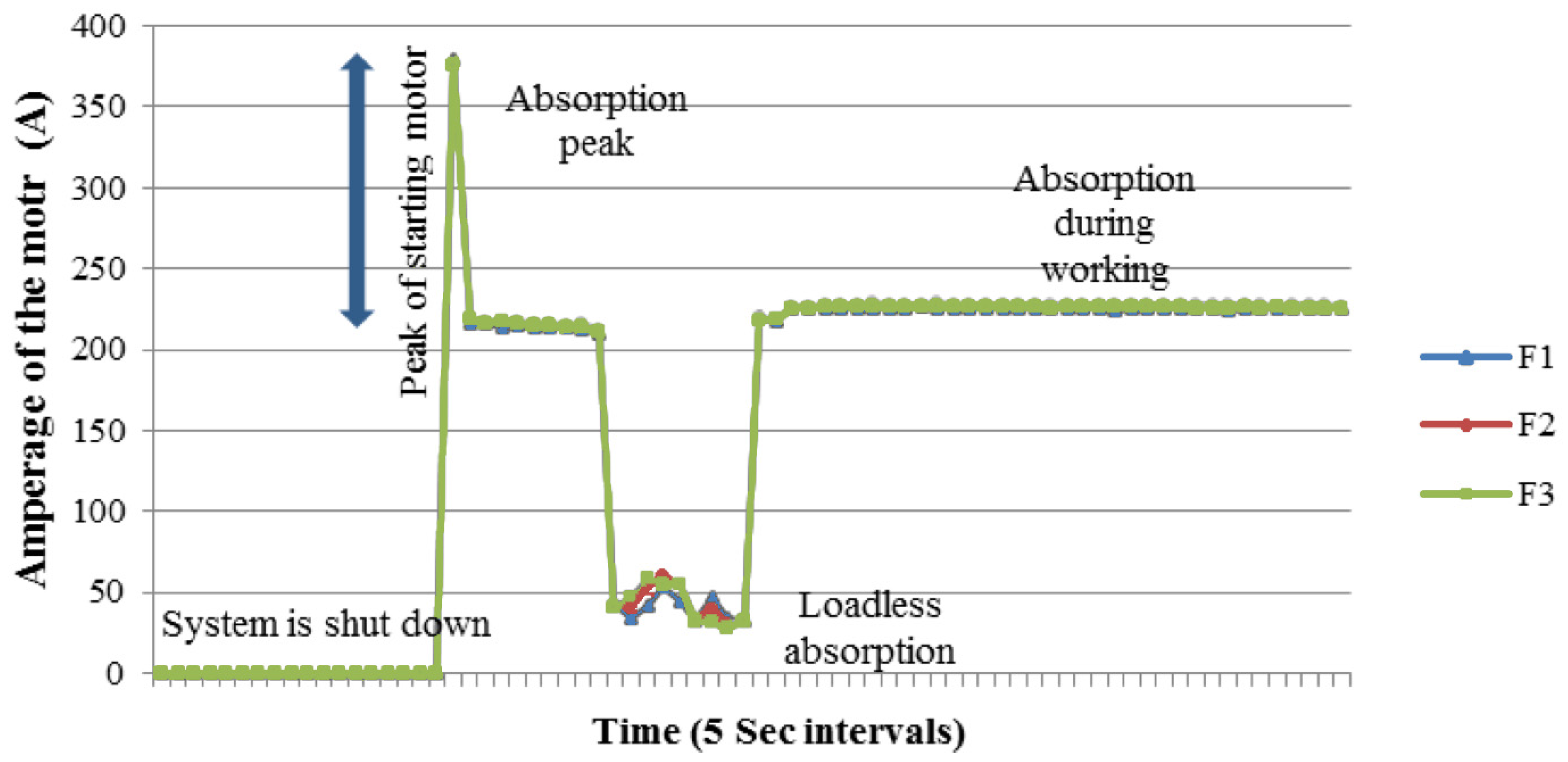
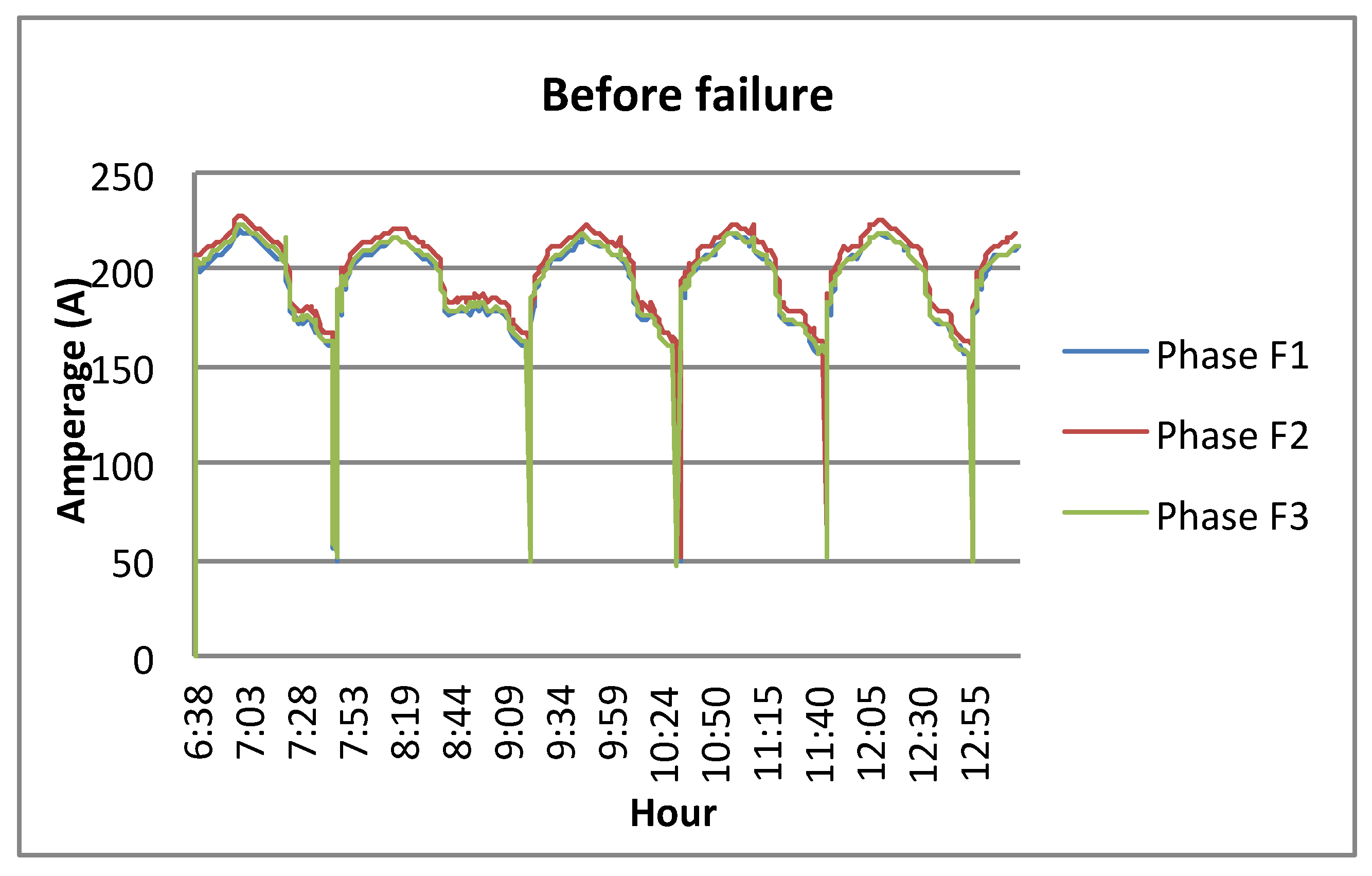
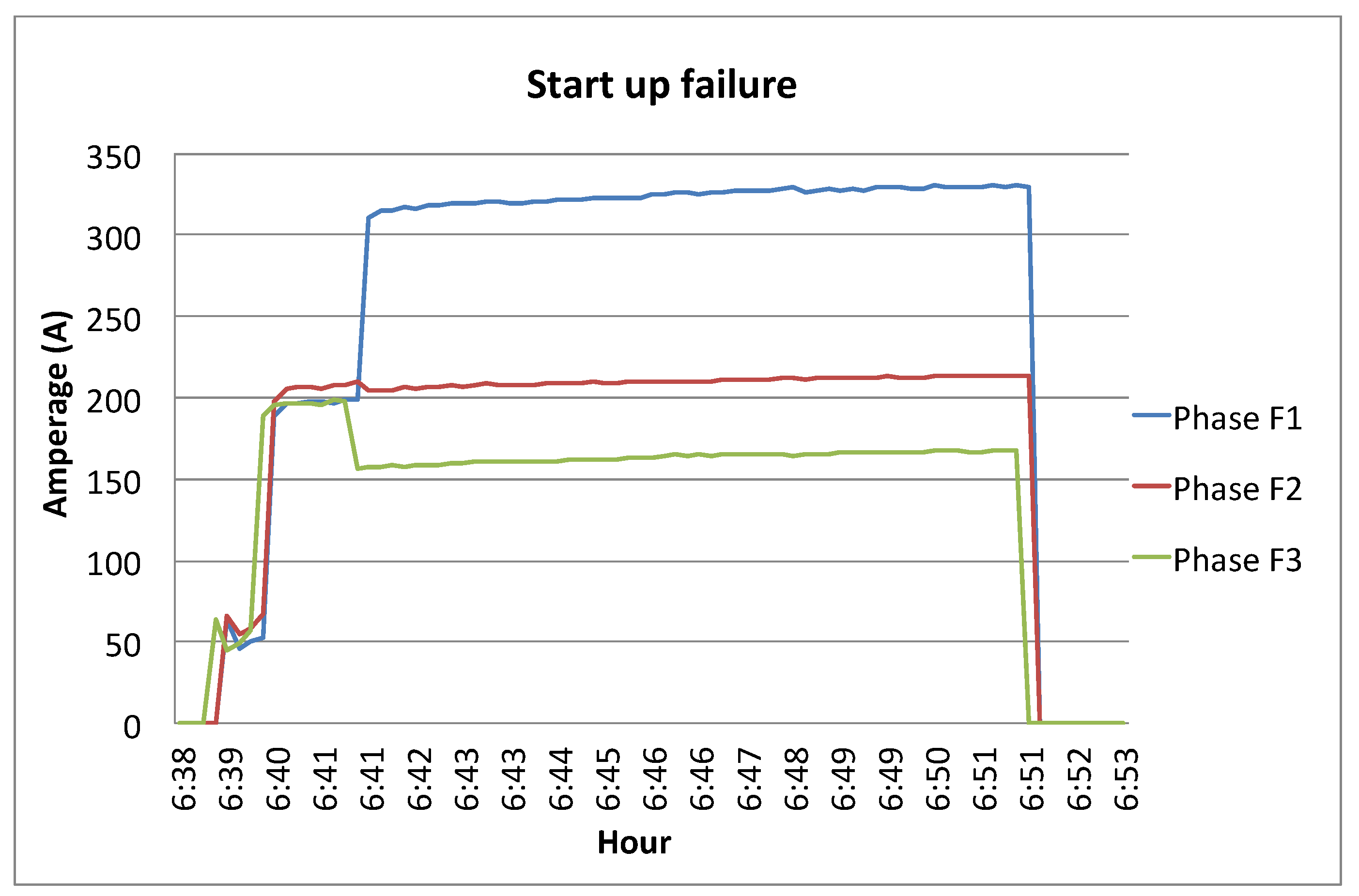
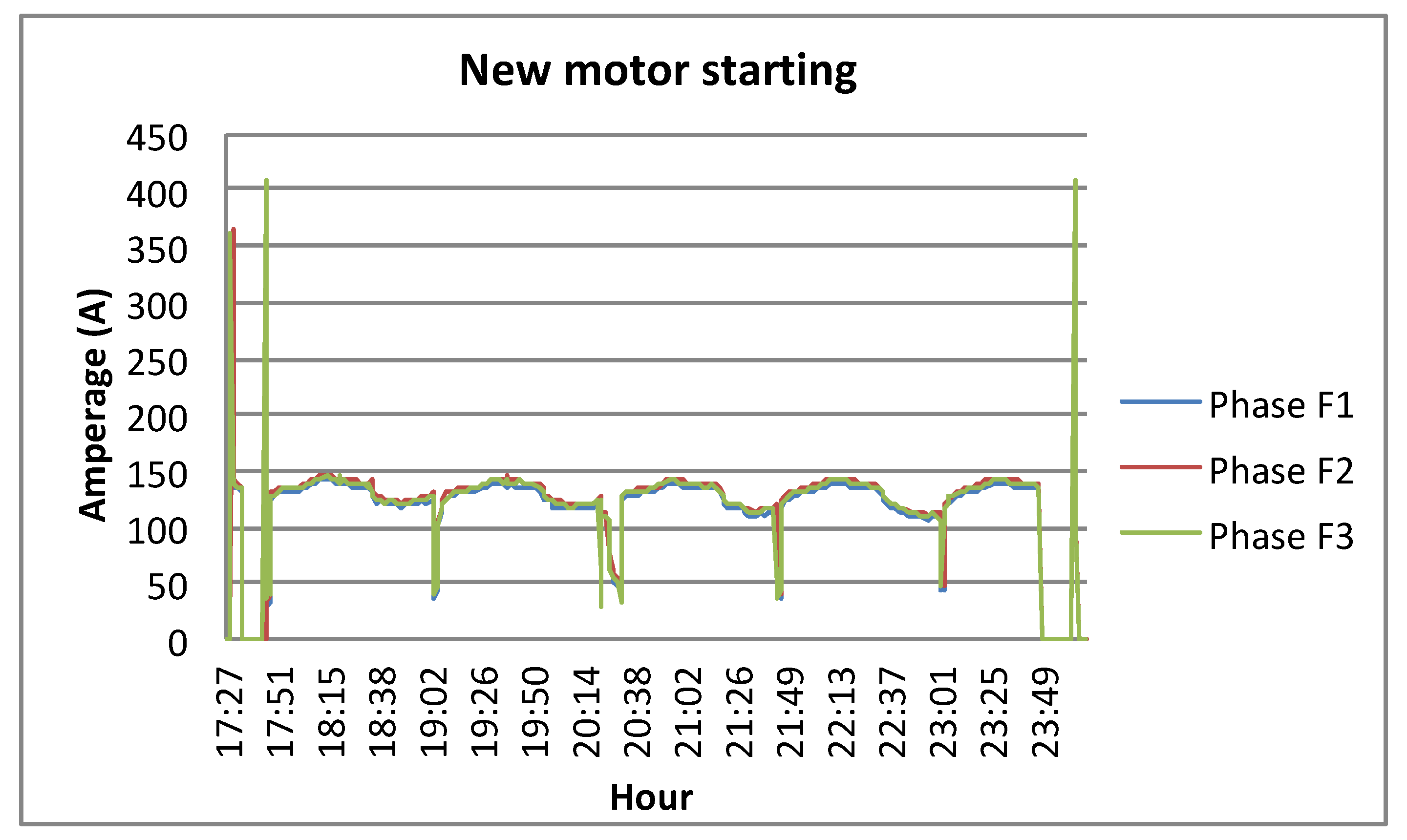
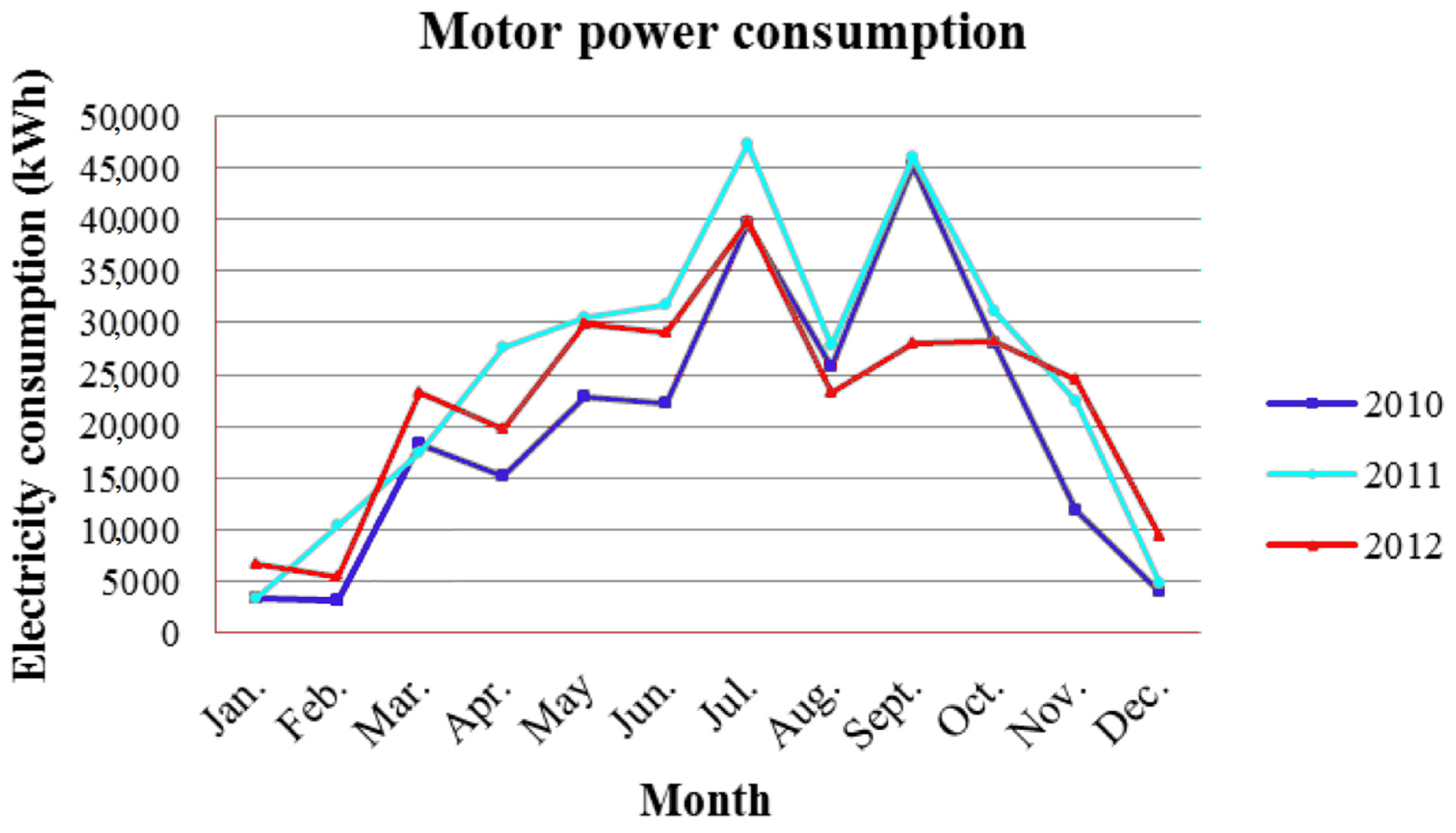
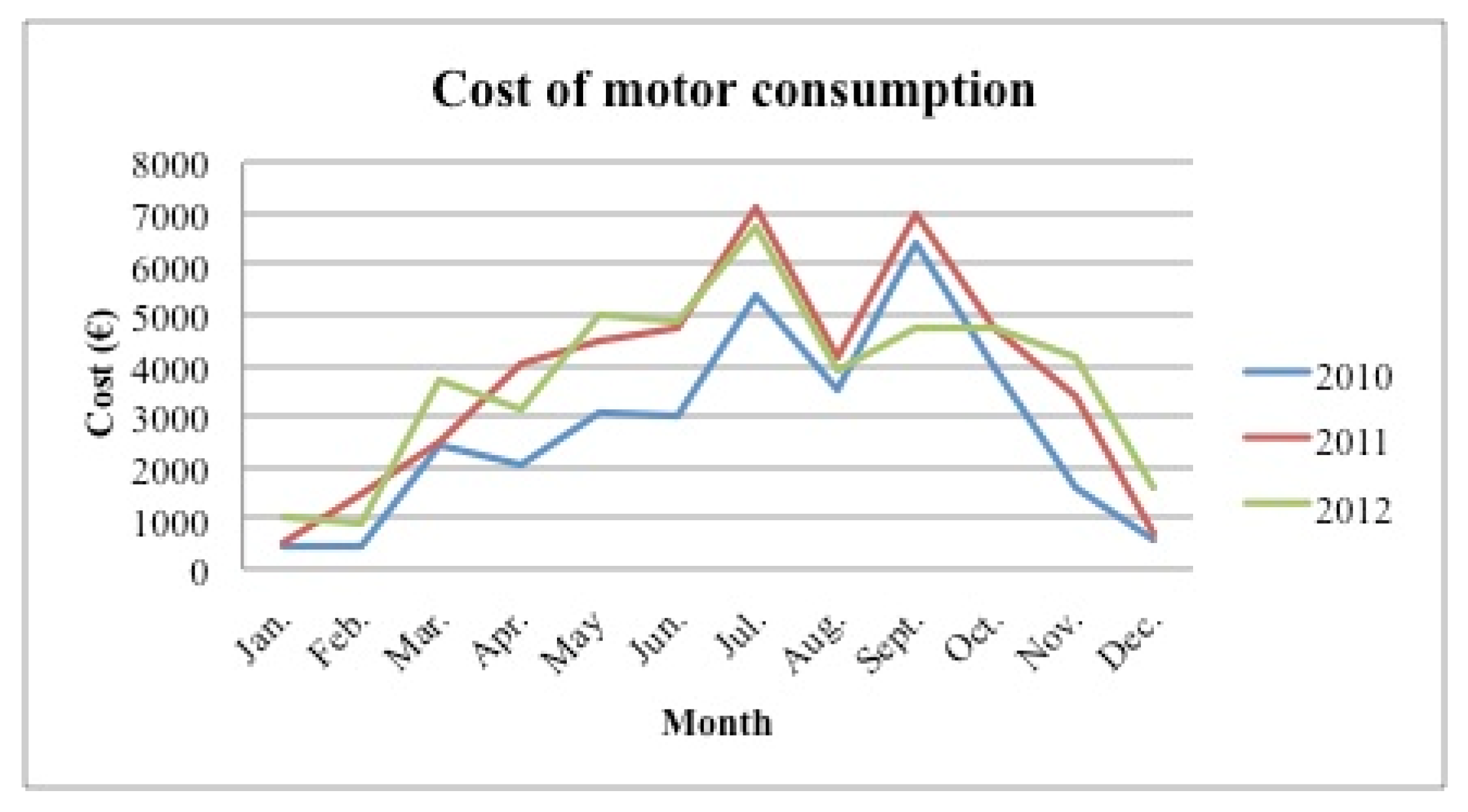
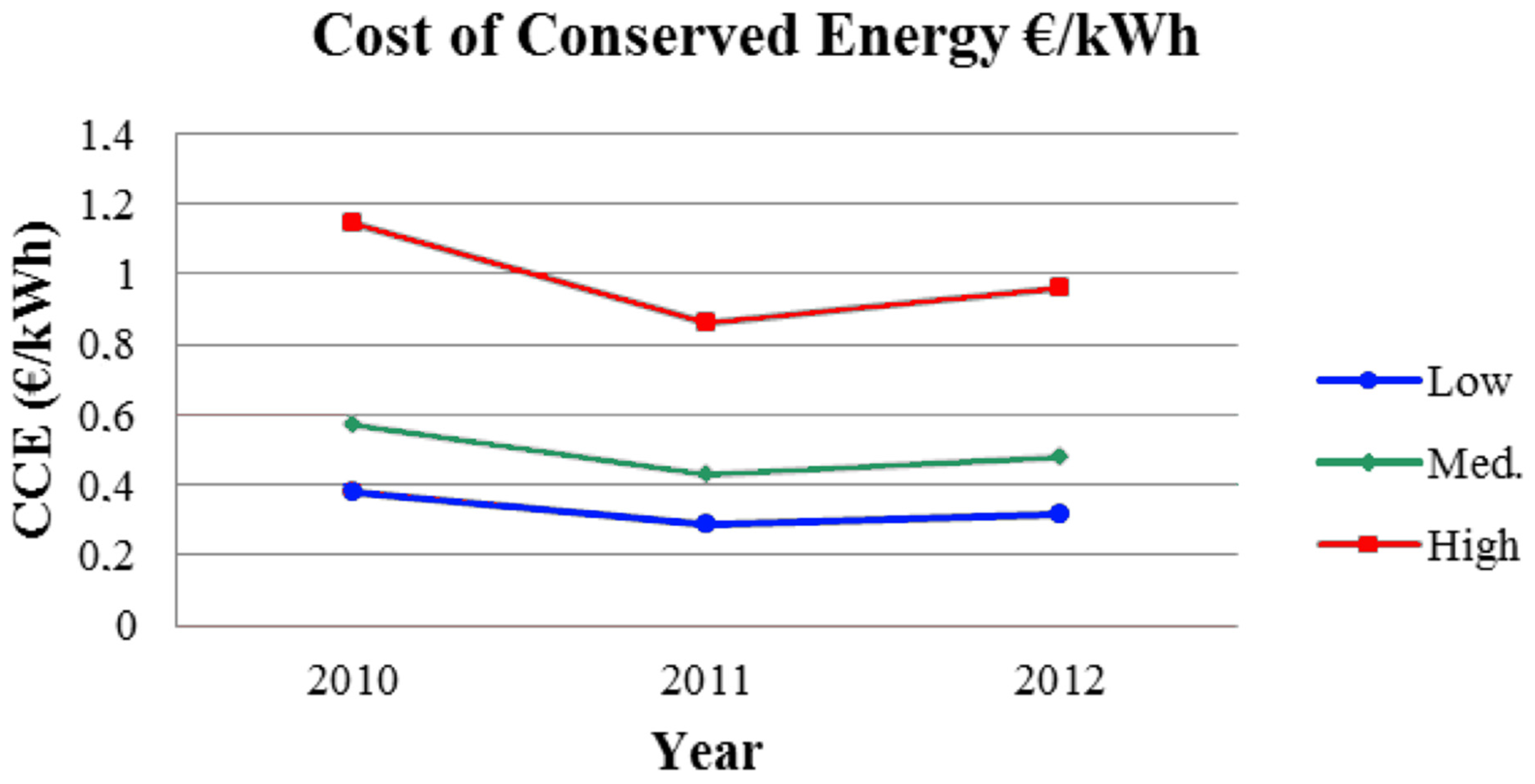
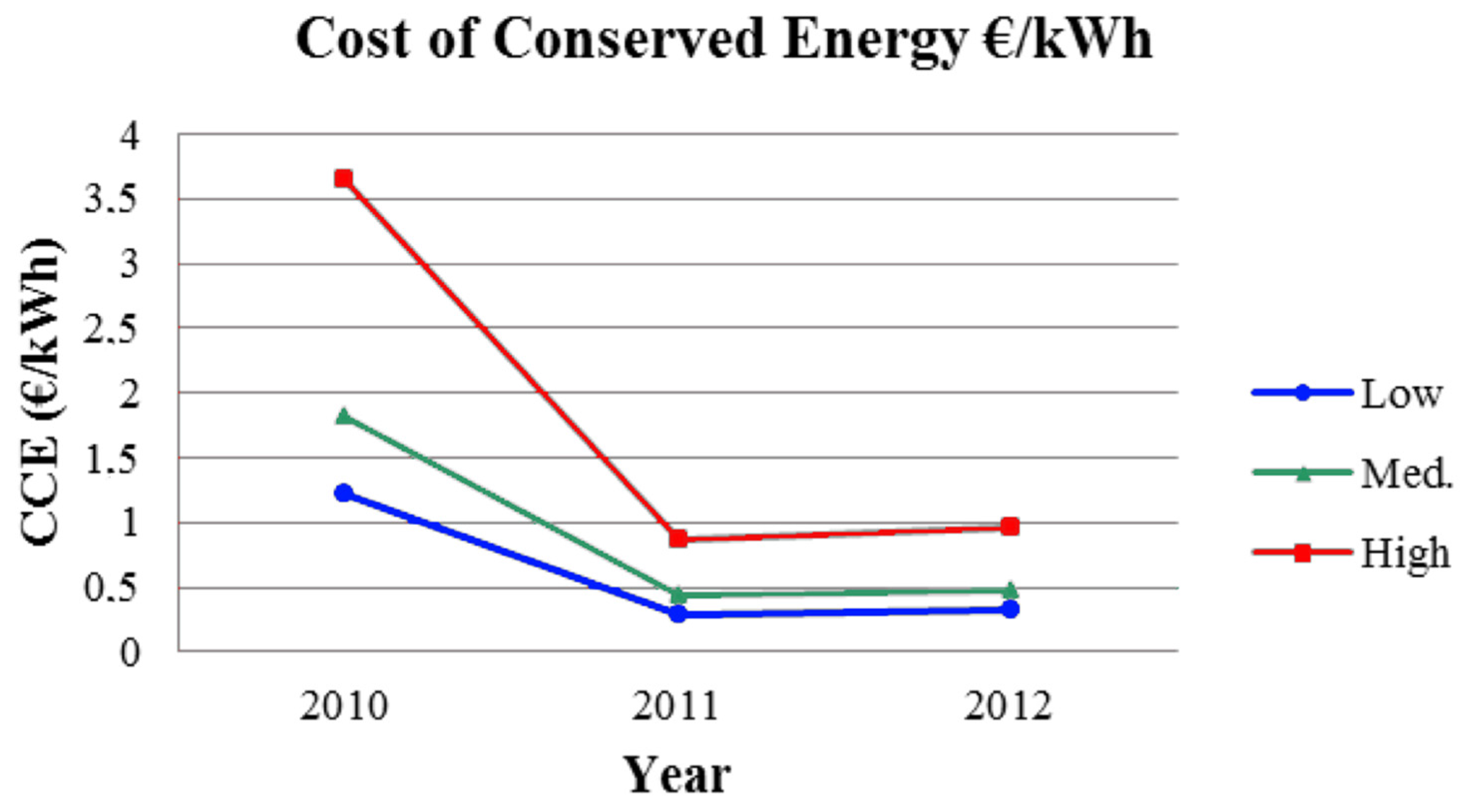
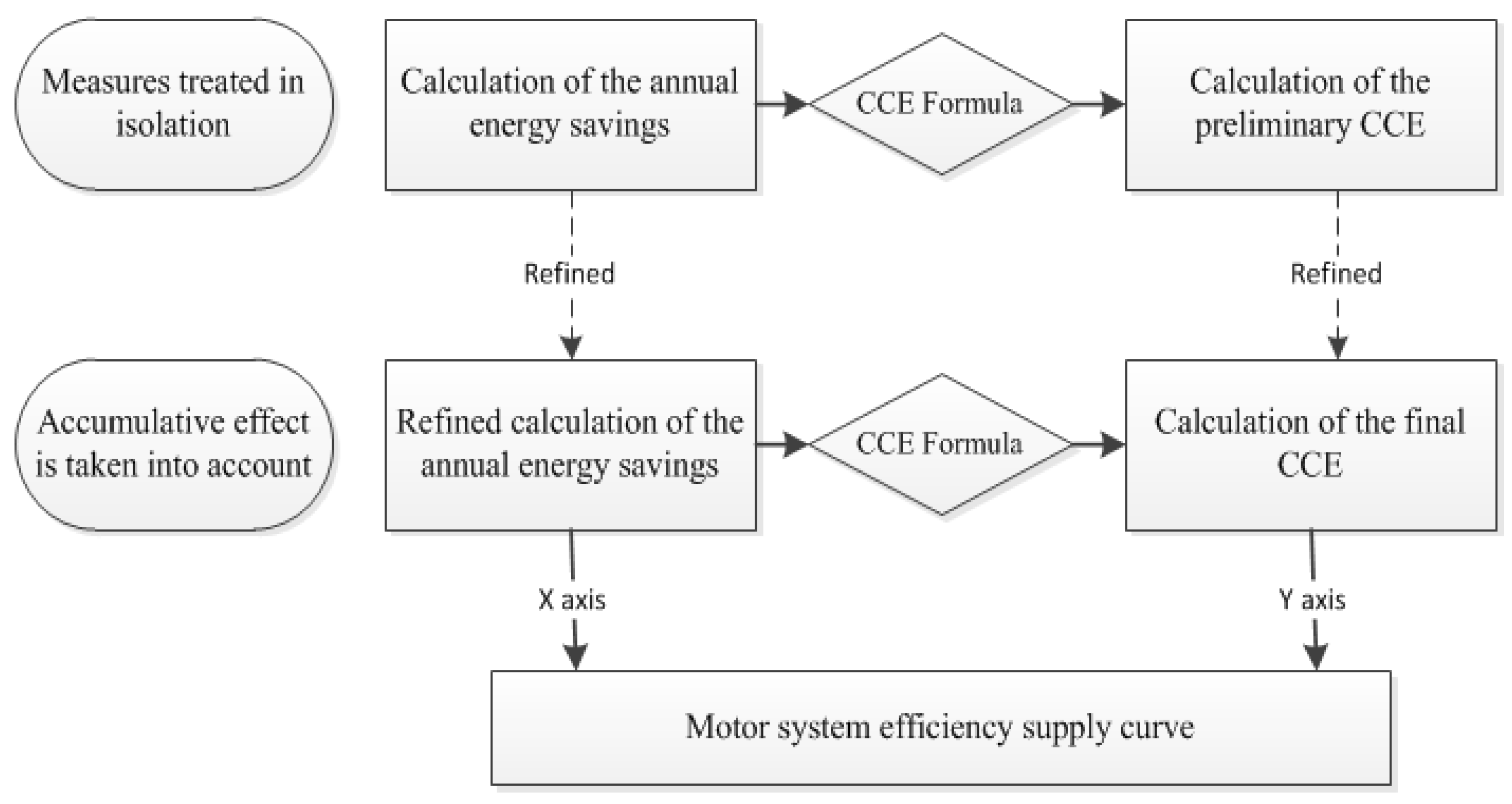
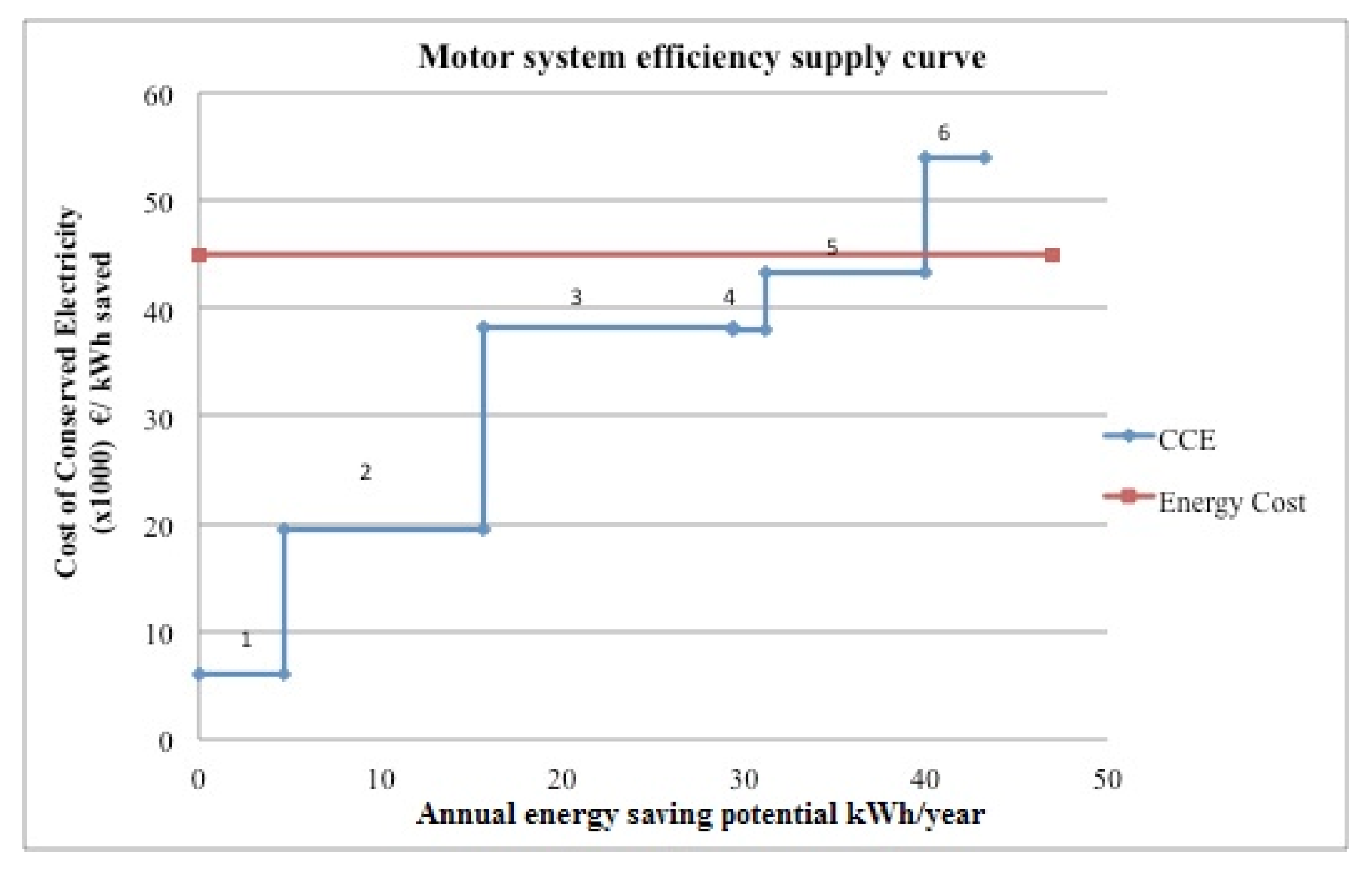

| Efficiency Base Case Scenarios | Characteristics | Possibility of Energy Recovery |
|---|---|---|
| Low Level | Maintenance policy is mainly reactive and limited to operations’ continuity. | 15% |
| Medium Level | Maintenance policy is mainly reactive, but includes some preventive actions. | 10% |
| High Level | Both routine and predictive maintenance are practiced. | 5% |
| Type | Action | Interval | Duration |
|---|---|---|---|
| Preventive | Terminal block tightening | 2 months | 10 min |
| Bearings greasing | 1 months | 5 min | |
| Belts tensioning | 1 months | 5 min | |
| Mill cleaning | 1 year | 2 h | |
| Corrective | Old motor repair | -- | -- |
| Transport damages repair | -- | 10 h | |
| Plant unavailability during motor substitution | -- |
| Motor System | Year | Cost of Maintenance Activities (€) | |
|---|---|---|---|
| Preventive | Corrective | ||
| Old Motor | 2008 | 5130.95 | - |
| 2009 | 5295.35 | - | |
| Old Motor failure and substitution | 2010 | 6110.15 | 2095 |
| New Motor | 2011 | 2922.10 | - |
| 2012 | 4401.55 | - | |
| Year | Average Production Capacity (t/h) | Average Electricity Cost (€/kWh) | Average Working Hours of Motor (h) | Average Electric Consumption of Motor (kWh) | Average Cost of Motor Consumption (€) |
|---|---|---|---|---|---|
| 2010 | 20.17 | 0.137 | 1958 | 239,504 | 32,971.07 |
| 2011 | 20.39 | 0.149 | 2528 | 300,154 | 44,891.85 |
| 2012 | 20.27 | 0.165 | 2250 | 267,154 | 44,535.77 |
| Energy Efficiency Measure | Potential Energy Recovery | I (€) | M&O (€) | ||
|---|---|---|---|---|---|
| Low | Med. | High | |||
| 1. Maintenance upgrading—Fix leaks, damaged seals and packing | 3.0 | 2.0 | 1.0 | 200 | 100 |
| 2. Maintenance upgrading—Remove sediments from mixer | 7.0 | 5.0 | 3.0 | 1500 | 700 |
| 3. Hardware improvement—Replace Motor with more energy efficient type | 14.0 | 7.0 | 5.0 | 6000 | 0 |
| 4. Hardware improvement—Use of new technologies and more efficient devices, like: new belts with higher power transition and maintenance free | 1.0 | 1.0 | 1.0 | 303.7 | -300 |
| 5. Maintenance advancement—Initiate predictive maintenance program | 7.0 | 5.0 | 2.0 | 2000 | 200 |
| 6. Hardware improvement—Use of inverter or variable speed drive | 8.0 | 5.0 | 2.0 | 5000 | 0 |
| 6a. Operational optimization—management of motor consumption, to minimize peaks at work start/stop | 5.0 | 2.0 | 1.0 | 250 | 0 |
| No. | Energy Efficiency Measure | Energy Recovery (%) | Cumulative Annual Energy Saving (kWh/year) | Final CCE (€/kWh-Saved) |
|---|---|---|---|---|
| 1 | Upgrade system maintenance—fixing leaks and damaged seals | 2.0 | 4696 | 6056 |
| 2 | Upgrade system maintenance—Removing mixer sediments | 5.0 | 15,668 | 19,350 |
| 3 | Hardware improvement—Further motor replacement with a more efficient one | 7.0 | 29,413 | 38,158 |
| 4 | Hardware improvement—Use of new belts | 1.0 | 31,240 | 38,098 |
| 5 | Maintenance advancement—Initiate a predictive maintenance program | 7.0 | 39,917 | 43,214 |
| 6 | Hardware improvement—Use of an inverter | 2.0 | 43,189 | 53,888 |
© 2018 by the authors. Licensee MDPI, Basel, Switzerland. This article is an open access article distributed under the terms and conditions of the Creative Commons Attribution (CC BY) license (http://creativecommons.org/licenses/by/4.0/).
Share and Cite
Demichela, M.; Baldissone, G.; Darabnia, B. Using Field Data for Energy Efficiency Based on Maintenance and Operational Optimisation. A Step towards PHM in Process Plants. Processes 2018, 6, 25. https://doi.org/10.3390/pr6030025
Demichela M, Baldissone G, Darabnia B. Using Field Data for Energy Efficiency Based on Maintenance and Operational Optimisation. A Step towards PHM in Process Plants. Processes. 2018; 6(3):25. https://doi.org/10.3390/pr6030025
Chicago/Turabian StyleDemichela, Micaela, Gabriele Baldissone, and Behnoush Darabnia. 2018. "Using Field Data for Energy Efficiency Based on Maintenance and Operational Optimisation. A Step towards PHM in Process Plants" Processes 6, no. 3: 25. https://doi.org/10.3390/pr6030025
APA StyleDemichela, M., Baldissone, G., & Darabnia, B. (2018). Using Field Data for Energy Efficiency Based on Maintenance and Operational Optimisation. A Step towards PHM in Process Plants. Processes, 6(3), 25. https://doi.org/10.3390/pr6030025




